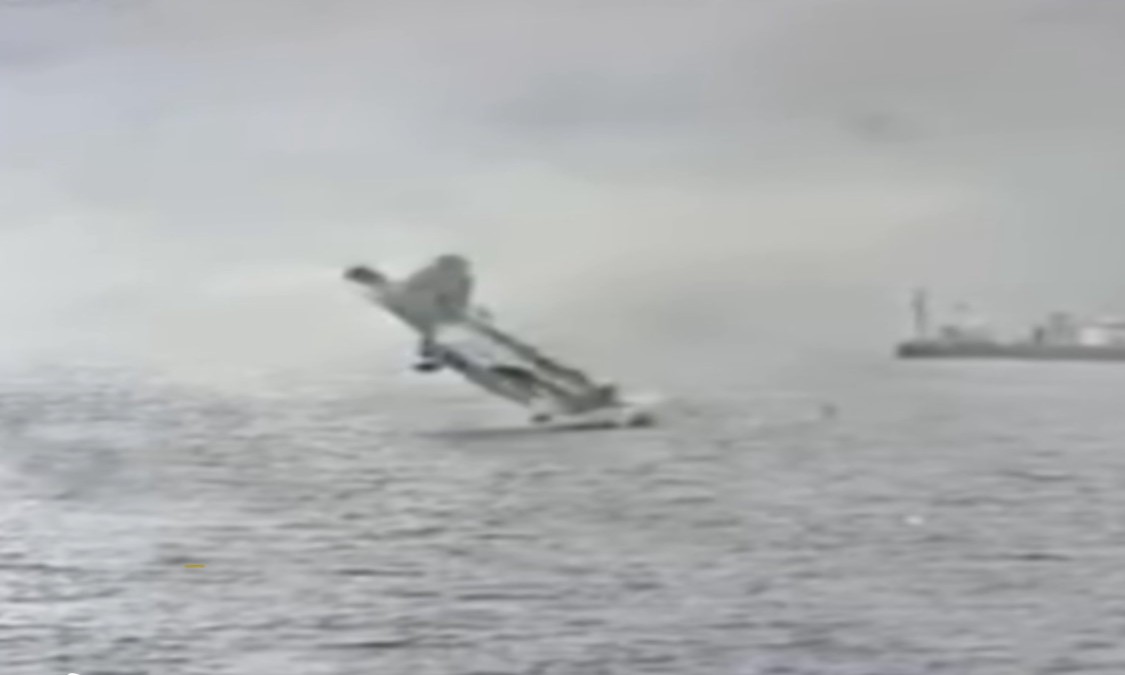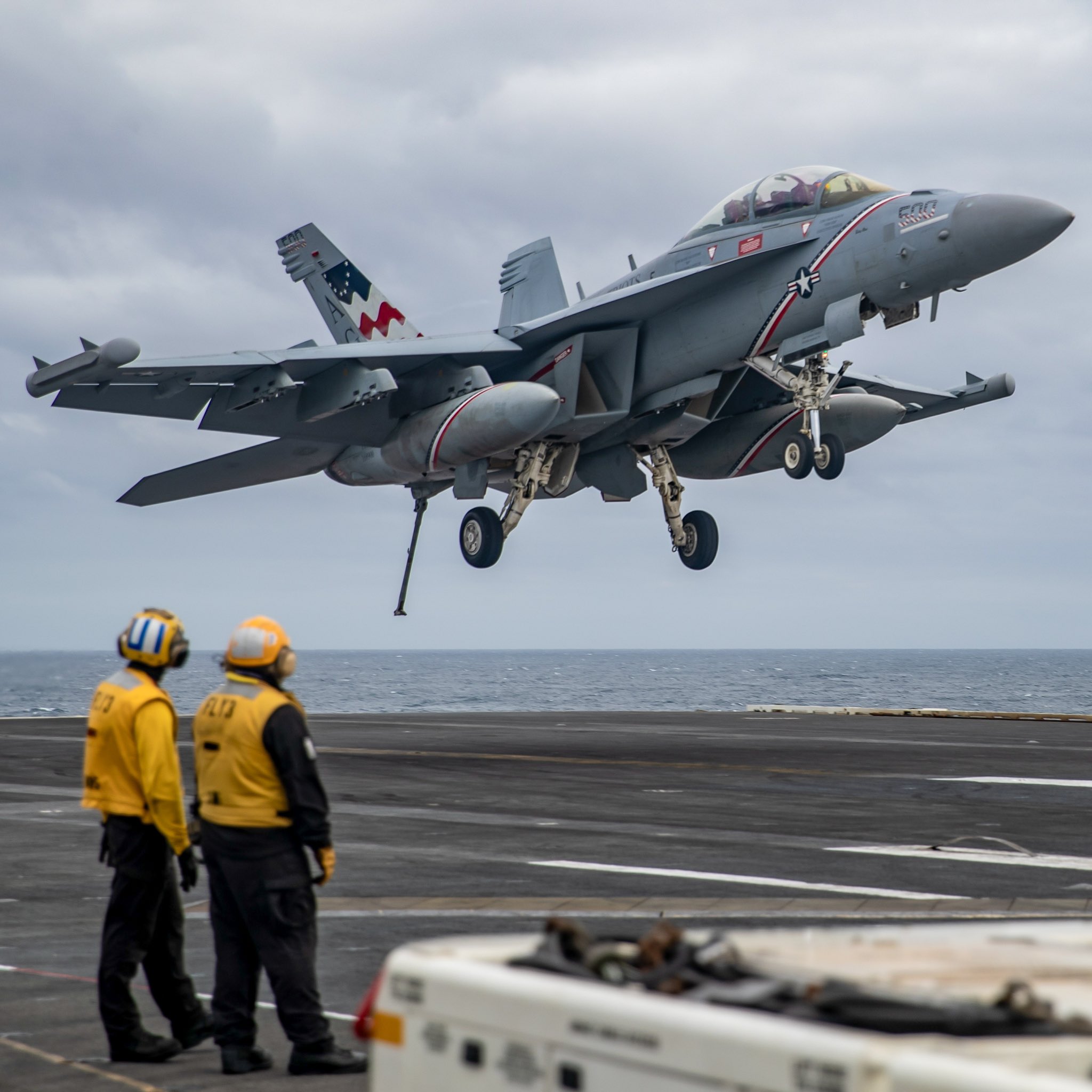A US Navy EA-18G Growler electronic warfare aircraft crashed into San Diego Bay on Feb 12 morning while attempting to land at Naval Air Station North Island.
The aircraft went down at approximately 10:15 a.m. local time, just off the coast near the naval base. Video footage captured the moment when the jet, descending at a steep angle, plunged nose-first into the water at high speed before disappearing from view.
Fortunately, both pilots ejected safely and were rescued by a nearby fishing boat, the US Coast Guard confirmed.
Commander Beth Teach, a Navy spokesperson, said the crash took place during a “go-around maneuver,” where an aircraft aborts its landing and takes off again.
The pilots, who have not yet been publicly identified, were in the water for about a minute before being pulled to safety. They were transported to a local hospital and are in stable condition, according to officials.
At the time of the crash, San Diego Bay was experiencing rainy and misty conditions. A full investigation is now underway to determine what led to the accident.
The aircraft, valued at just under $80 million, remains underwater in the bay. It is still unknown whether the pilots issued a distress signal before the crash.
The Navy reported that they had identified the underwater crash site, with Harbor Security boats present at the location as crews worked to reduce any potential environmental impact caused by the submerged aircraft.
The service said, “The public is reminded to not approach, touch, or collect any debris that may wash ashore. Anyone who encounters suspected aircraft debris should report it to local authorities or call Naval Base Coronado.”
According to reports, the Growler may have been participating in Exercise Bamboo Eagle 25-1, a multinational training drill designed to increase interoperability among allied air forces. The exercise, led by the US Air Force Warfare Center, includes participation from the Royal Air Force, Royal Australian Air Force, and, for the first time, the Royal Canadian Air Force.
With a focus on Agile Combat Employment, the training aims to prepare forces for rapid deployment and sustained operations under contested conditions. Maj. Gen. Christopher Niemi said that such exercises strengthen allied capabilities in response to emerging threats.

US Navy EA-18G Growler
The EA-18G Growler is a specialized variant of the F/A-18 Super Hornet, designed to provide advanced electronic warfare capabilities.
The Growler is equipped with sophisticated radar jamming, signal disruption, and electronic attack systems, making it a crucial asset in modern air combat. The aircraft is capable of suppressing enemy air defenses, disrupting communications, and supporting strike missions in high-threat environments.
The Growler is primarily operated by electronic attack squadrons within the US Navy, including VAQ-135, which is based at Naval Air Station (NAS) Whidbey Island, Washington.
The first operational Growler was delivered to Whidbey Island in 2008, and since then, the aircraft has played a vital role in global military operations.
The Growler’s two-seat configuration consists of a pilot in the front and an electronic warfare officer (EWO) in the rear, who manages the aircraft’s complex jamming and countermeasure systems.

The February 12, 2025, crash of an EA-18G Growler in San Diego Bay marks the second major accident involving the aircraft in just three months, raising concerns about potential safety issues.
This latest incident follows a tragic October 15, 2024, crash near Mount Rainier, Washington, which resulted in the deaths of two naval aviators.
In the October accident, the aircraft, assigned to Electronic Attack Squadron 130 (VAQ-130), crashed at 3:23 p.m. local time.
Search and recovery teams located the wreckage the following day, but the identities of the two lost aviators—Lt. Cmdr. Lyndsay “Miley” Evans and Lt. Serena “Dug” Wileman—were not publicly confirmed until October 21.
The aircraft was in service with VAQ-130 “Zappers”, the oldest electronic warfare squadron in the US Navy. At the time of the crash, the squadron had returned to its homeport following a combat deployment with Carrier Air Wing 3 (CVW-3) aboard the Nimitz-class aircraft carrier USS Dwight D. Eisenhower (CVN-69).
During its deployment, VAQ-130 played a key role in Operation Prosperity Guardian, conducting continuous combat operations across strategic waterways, including the Southern Red Sea, the Bab al-Mandeb Strait, and the Gulf of Aden.
The Zappers made history during this deployment by being the first EA-18G squadron to achieve an air-to-air kill, successfully shooting down a Houthi drone while operating in the Red Sea.
Additionally, Growlers from the USS Eisenhower’s air wing employed the AGM-88E Advanced Anti-Radiation Guided Missile (AARGM) for the first time in combat. The missile was used to destroy a Mi-24/35 “Hind” attack helicopter while it was parked on the ground.
Experts Puzzled By The Crash
Aviation experts and former military pilots are grappling with unanswered questions surrounding the US Navy EA-18G Growler crash into San Diego Bay on February 12, 2025.
While the two pilots miraculously survived, the incident has raised serious concerns about what might have caused a state-of-the-art electronic warfare aircraft to go down during a routine maneuver.
Dr. Rex Rivolo, a former Pentagon analyst who evaluated F/A-18 aircraft from 1992 to 2009, expressed his shock over the accident, calling it “absurd” for such a modern aircraft to crash under non-combat conditions.
“For a modern aircraft with two engines, not in combat, not on the range, just flying around to crash, is just absurd,” Rivolo told 10News.
Having extensively studied and flown in the Growler’s predecessor, Rivolo described the aircraft as a “super shining star” in terms of performance and reliability.
“There were never any issues. It performed better than it was designed to do, and it never really had any concerns of any kind,” he said. “The program was really a showpiece of how to do things right.”
Rivolo believes the investigation will quickly yield answers, given that both pilots survived. However, he raised key questions, particularly whether the aircraft was actually on a landing approach as the Navy reported and what flight conditions were at the time of the crash.
Retired Marine Corps pilot Ron Alvarado, speaking to NBC 7, analyzed the crash location near Point Loma and suggested that the aircraft may have been in a turn when it lost lift or control inputs.
“It could have flown until it lost lift or the inputs that the pilot last put into the controls had it going into the left turn, whereupon it actually crashed into the bay,” Alvarado explained.
He also speculated that the pilots may have deliberately steered the aircraft away from land to avoid structures and populated areas, ensuring minimal damage.
On the other hand, Jim Kidrick, a retired Navy commander and fighter pilot, as well as the CEO of the San Diego Air and Space Museum, stressed the importance of evaluating pilot training and mission preparedness on the day of the crash.
“First question is, was that aircrew trained to do that mission that day? Because that really has a lot to do with skillsets, the performance of the aircrew,” Kidrick said. While many questions remain, Kidrick noted that the most important outcome was the survival of both pilots.
“This had really a pretty good ending,” he said. “The ending is both of them alive, and most likely, they’ll live to fly another day.”
As the investigation progresses, military officials and aviation experts are working to determine the cause of the crash to prevent similar incidents involving the Navy’s highly advanced electronic warfare aircraft.
- Contact the author at ashishmichel(at)gmail.com
- Follow EurAsian Times on Google News




